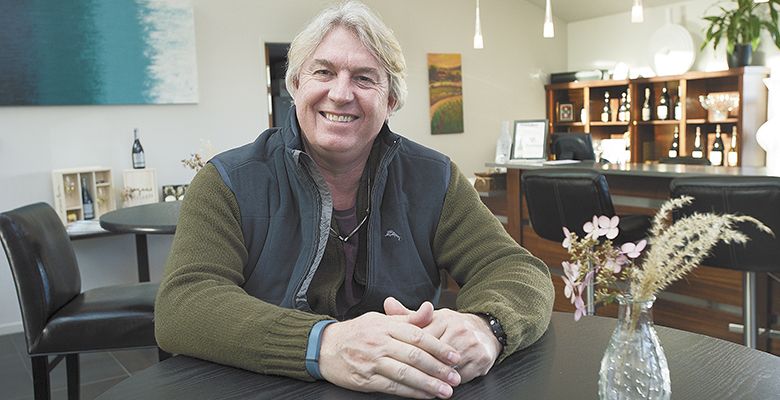Montalieu Shares His View
Willamette Valley vintner talks Oregon, France and future
Over the course of 28 years in Oregon, Laurent Montalieu, a French transplant who first learned winemaking in his native Bordeaux, has had considerable influence over the industry.
Montalieu held winemaker positions at Bridgeview Vineyards and WillaKenzie Estate before planting the 80-acre Domaine Danielle Laurent Vineyard in 2000 and founding Soléna Estate in 2002 with wife Danielle Andrus Montalieu.
The Montalieus joined forces with Oregon Wine Services & Storage owner John Niemeyer in 2003, signaling the beginning of a synergistic relationship that has resulted in the development of Oregon’s second-largest winery.
Montalieu took the measure of Oregon’s industry and created NW Wine Company’s full-service, custom crush operation that has thus far been responsible for the launching of more than 50 brands. Additionally, NW Wine’s own brands rank it fifth among all Oregon wineries.
He gives full credit to Niemeyer, whose financial backing made it all possible. But no one denies Montalieu’s innovative decisions and entrepreneurial drive have been primarily responsible for the company’s success.
Acquisition of the prized Hyland Vineyard in the McMinnville AVA and launching of the Hyland brand is the company’s most recent achievement of note. First planted in 1971, its 100-acres in vines, and 200 overall, make this property a central jewel in NW Wine’s crown.
Given his long experience plus deep commitment to the Oregon wine industry, Montalieu’s opinion is much respected. Sitting down with him to gain a better grasp of his views and perspectives led to a discourse filled with thoughtful reflection and insight.
KK: A lot has happened since you first came to Oregon in 1986. Back then there were only a few small, hands-on producers. How do you feel about today by comparison?
LM: Well, it’s been 50 years since David Lett put that first stake in Willamette Valley ground, and it’s an industry where small growers and wineries are still in the vast majority.
That’s why we see a bright future for NW Wine, serving all those people who don’t want or need brick and mortar. They appreciate the guidance we give them, and they can focus more time on marketing their wines.
KK: How does the trend look to you? Do you think the majority of growers and winemakers will remain small and hands on?
LM: I was fortunate enough to be president of the Willamette Valley Wineries Association recently, and there is a solid core of smaller owners who are working together to build Oregon’s reputation, particularly for Pinot Noir.
It’s pretty hard to guess what could happen a long way down the road. But, this group of dedicated owners is still very much alive and involved. And there’s even quite a few of the second generation coming up who will eventually take their place.
People continue to come to Oregon to visit and like it so much they want to live here. The grower and winemaker lifestyle appeals to them, so it’s what they decide to do. Even though getting into the wine business is a challenge and a half, it becomes their life. They want to make really great wine and they dedicate themselves to doing just that.
KK: Still, it seems that more out-of-state and even international players are getting into the game. What thoughts do you have about how that will impact Oregon?
LM: I know the French firms that have invested here are very sensitive about focusing on consistently high quality and what it takes to achieve that. I’ve talked with Robert Drouhin several times, and I’ve already gotten to know Louis Jadot winemaker, Jacques Lardier, who came out of retirement because he wanted to take advantage of the opportunity at Resonance Vineyards.
They both seem to be very much attuned to the Oregon philosophy and eager to follow it. This is not surprising to me because the great Burgundy vignerons are accustomed to working in this same way. Small quantities, minimum handling, careful winemaking practices, barrel fermenting, barrel aging. It’s expensive, but it works beautifully.
KK: You dealt with the top Jackson Family Wines people when they came to look over Grand Crus Estates. What was that like?
LM: Barbara Banke came up from Santa Rosa. She was named chairman after her husband (Jake Jackson) died, and she made a point to personally evaluate the Grand Cru Estates purchase. Even though we worked mostly with the company’s COO, Hugh Reimers, on the details, Barbara seems quite excited about Jackson Family playing a role in Oregon.
KK: What have you seen over the years that makes you the most excited for the future of Oregon wine?
LM: Well, when I speak about wine, of course, I am referring primarily to Pinot Noir. And what I can say about that is how the sense of place is becoming more defined, and the challenges we have had in consistently making good wine are pretty much behind us now.
KK: You mean that you can overcome the obstacles even when Mother Nature isn’t so kind to us at harvest time?
LM: Exactly. Unless the weather is a total disaster at harvest — and it has only come close to that once or twice in all the years I have been here — there is no excuse for not making good wine every year.
We know how to deal with difficulties that crop up in the vineyard and we can quickly identify problems in the winery and resolve them. Then, when we do have those outstanding years like 2012 and 2014, we are given the gift of being able to make truly great wine.
KK: You mentioned the recognition of distinctive AVAs. Do you think that will continue to evolve in Oregon?
LM: For sure. The Yamhill Valley is truly exceptional because we have so many different soil types, sites and favorable meso-climates, but I’m certain there are others we haven’t yet identified in places around the state.
The McMinnville AVA is only beginning to show its potential, and we are so glad to be a part of it with Hyland Vineyard. Other spots are already showing distinctive characteristics like Maysara, and Yamhill Valley Vineyards was one of the pioneers of the industry that proved the AVA’s potential even before it was designated.
I can give you an example right now that I’m positive will qualify for an AVA designation. That is the area around Monmouth where we have already planted two vineyards, Domaine Loubejac and Wildwoode. We own 200 acres there, rolling hills, elevations for 300 to 600 feet. I’ve flown over in a helicopter, and I’d say the area has at least 1,000 acres with prime potential.
KK: Domaine Loubejac?
LM: It’s the name of the little village in Bordeaux where I grew up.
KK: Do you ever get together with other winery people and talk about the future, kind of speculate on what things will be like years from now. Size? Popularity? Climate change?
LM: Not as such. But it sounds like an interesting idea. As for climate change, it seems apparent that something will happen over time, but I doubt it will have much effect on things until my grandchildren are grown.


 Karl Klooster is the associate editor of the Oregon Wine Press and writes a wine column for the
Karl Klooster is the associate editor of the Oregon Wine Press and writes a wine column for the 






